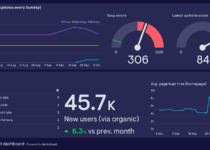How Interactive Email Widgets Marketing Boosts Conversions
While most marketers continue to send static emails that often go ignored, a select few are transforming their inboxes into dynamic conversion engines. Emails that contained interactive elements achieved an average click-to-open rate of 18% in 2024, compared with a 12% CTOR for non-interactive emails—a 50% performance improvement that most marketers are leaving on the table.
What’s the best way for marketers to implement interactive elements into their email marketing strategies? Widgets offer multiple benefits: they collect data, provide personalized recommendations, and can send updates to your recipients in real time. Plus, interactive email widgets are more engaging, leading to higher conversion rates.
Interactive email widgets marketing represents the next evolution of email engagement, moving beyond static content to create dynamic experiences directly within the inbox. Despite these proven results, only 28% of email marketers reported regularly using interactive elements in their 2024 campaigns, creating a significant opportunity for early adopters to outperform their competition.
Key Takeaways
- Interactive email widgets marketing delivers 50% better performance than static emails, with interactive elements achieving an 18% click-to-open rate compared to 12% for traditional emails, yet only 28% of marketers use them regularly.
- Gamified widgets provide the highest ROI potential with spin-to-win elements driving up to 300% return on investment, while AMP-powered live data widgets can achieve 500% conversion lifts for real-time inventory and pricing.
- Strategic widget deployment based on funnel stages maximizes results by using polls for top-funnel engagement, product carousels for consideration-stage prospects, and booking calendars for ready-to-buy customers.
- Technical success requires progressive enhancement with fallbacks since only 50% of email clients fully support interactivity, making well-designed static alternatives essential for universal compatibility.
- Specialized tracking methods are crucial for measuring true impact including multi-pixel tracking for widget interactions, UTM parameters for attribution, and platform-specific analytics to capture engagement beyond traditional email metrics.
TABLE OF CONTENTS:
What Are Interactive Email Widgets?
Before we cover interactive email widgets, let’s define classic email widgets. This is software embedded into emails that offer a more dynamic experience for recipients. Most marketers utilize email widgets to enhance personalization and deliver tailored recommendations, but there are numerous types of email widgets available.
This brings us to interactive email widgets. Interactive email widgets are embedded elements that enable direct user engagement within emails without redirecting to external pages. These include polls, product carousels, quizzes, booking calendars, and gamified features like spin-to-win wheels.
The evolution stems from advances in HTML and email client capabilities, transitioning from basic animated GIFs to AMP-powered dynamic content that pulls live data. Interactive email widgets differ from others due to these reasons:
- Direct interactivity: Users can click, hover, or input data directly within the email.
- Contextual functionality: Widgets like calendars enable appointment booking, while carousels mimic website product browsing.
- AMP integration: Allows real-time content updates, such as live inventory counts or pricing.
Performance Metrics That Matter
The data doesn’t lie. Interactive email widgets marketing delivers measurable results across every metric that matters to your bottom line.
| Widget Type | Average Performance Lift | Primary Use Cases |
|---|---|---|
| Embedded Forms | 257% response increase | Surveys, lead generation |
| Product Carousels | 30% higher CTR | E-commerce showcases |
| Gamified Elements | 300% ROI increase | Promotions, loyalty programs |
| AMP Live Data | 500% conversion lift | Real-time inventory, pricing |
The most compelling proof comes from real-world implementations. Mailmodo’s e-commerce client portfolio saw campaigns featuring interactive carousels drive a 30% higher CTR and a 20% lift in conversions compared to static-image emails.
“Interactive carousels compress rich product discovery into a single email, translating directly into higher clicks and on-site purchases.” – Mailmodo Research Team
But the real game-changer? Gamified “spin-to-win” email widgets have been shown to drive a return on investment of up to 300% (3×) for e-commerce brands. This isn’t just about engagement. It’s about revenue.
Strategic Implementation Framework
Success with interactive email widgets marketing requires a strategic approach that maps widget types to specific funnel stages and audience segments.
Segmentation-First Approach
Use these widgets based on where subscribers are in their journey:
- Top of funnel: Polls and quizzes to gather preferences and increase engagement.
- Middle funnel: Product carousels and comparison tools for consideration-stage prospects.
- Bottom funnel: Booking calendars and “add to cart” buttons for ready-to-buy customers.
- Retention: Gamified loyalty widgets and feedback forms for existing customers.
Technical Execution Best Practices
The email service provider (ESP) you use can make or break your interactive email campaigns. Here’s what works:
- Progressive enhancement: Design fallbacks for non-supportive clients with static images where widgets fail.
- Mobile optimization: Ensure touch-friendly taps with minimum 44px buttons, as 41.6% of emails are opened on mobile.
- Loading optimization: Use SVG graphics and optimize images to prevent delays that kill engagement.
For email marketing platforms, tools like Mailmodo and Dyspatch offer no-code widget builders with pre-tested client compatibility, reducing technical barriers significantly.
Overcoming Implementation Challenges
The biggest hurdle isn’t always technical. Marketers can struggle to measure success with email marketing widgets. Traditional email analytics weren’t designed for in-email interactions, creating gaps that can hide your true ROI. Additionally, interactive email widgets may not be suitable for every strategy. Here’s a deeper look at both of these challenges.
Measurement Solutions
Interactive email widgets have been shown to boost metrics such as time-on-email and CTRs while reducing bounce rates. But successful interactive email widgets marketing requires specialized approaches:
- Multi-pixel tracking: Trigger an “engagement event” when users interact with widgets.
- UTM parameter integration: Track widget-specific traffic sources and conversions.
- Platform-specific analytics: Use tools like Mailmodo’s interaction heatmaps for deeper insights.
Client Compatibility Strategy
Not all email clients fully support interactivity, but this limitation can actually become an advantage when you plan for it. Use CSS-based interactivity rather than JavaScript, and always provide meaningful fallbacks.
The key is treating non-interactive fallbacks as opportunities, not limitations. A well-designed static fallback can still outperform traditional emails while ensuring universal compatibility.
The Future of Interactive Email Marketing
Looking ahead to 2025 and beyond, interactive email widgets marketing is evolving toward even more sophisticated personalization and automation.
AI-driven widgets that generate dynamic content based on user behavior will become standard practice. We’re already seeing early implementations of predictive product recommendations and personalized quiz paths that adapt in real-time.
Voice interaction within emails is emerging as the next frontier, with early tests showing promise for simple commands like “Add to cart” or “Schedule meeting.”
Maximizing Your ROI with Interactive Widgets
Are you struggling to convert email subscribers with static emails? Interactive email widgets marketing boosts more engagement rates compared to static emails. Like classic email widgets, marketers can implement interactive software into their emails, such as quizzes and polls.
Interactive email widgets deliver measurable results that directly impact your bottom line. The brands winning with interactive email widgets marketing share three characteristics: they start with clear frameworks, they prioritize user experience over flashy features, and they treat email as a conversion platform, not just a communication channel.
The question isn’t whether to implement interactive email widgets, but how quickly you can get started before your competition catches up.
Ready to transform your email marketing from static to dynamic? We use AI and automation to keep you ahead of your competitors. Contact us to discover how we can generate real results for your business.
The post How Interactive Email Widgets Marketing Boosts Conversions appeared first on Single Grain.


